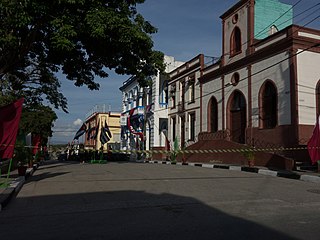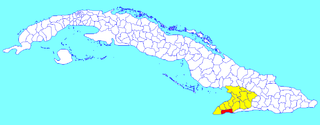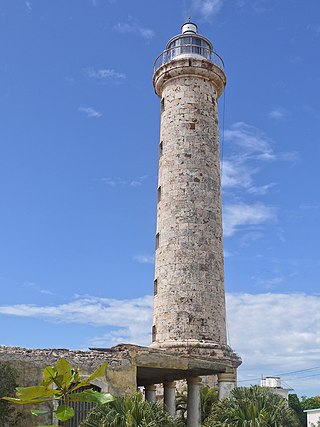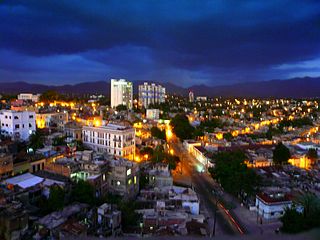
Granma is one of the provinces of Cuba. Its capital is Bayamo. Other towns include Manzanillo and Pilón.

Manzanillo is a municipality and city in the Granma Province of Cuba. By population, it is the 14th-largest Cuban city and the most populated one not being a provincial seat.

Bayamo is the capital city of the Granma Province of Cuba and one of the largest cities in the Oriente region.

The Sierra Maestra is a mountain range that runs westward across the south of the old Oriente Province in southeast Cuba, rising abruptly from the coast. The range falls mainly within the Santiago de Cuba and in Granma Provinces. Some view it as a series of connecting ranges, which join with others to the west. At 1,974 m (6,476 ft), Pico Turquino is the range's – and the country's – highest point. The area is rich in minerals, especially copper, manganese, chromium, and iron.

Palma Soriano is a Cuban city and municipality in the Santiago de Cuba Province. With a population of 119,740 in the city proper, it is the second-largest in the province and the 16th-largest in Cuba.

Yara is a small town and municipality in the Granma Province of Cuba, located halfway between the cities of Bayamo and Manzanillo, in the Gulf of Guacanayabo. Yara means "place" in the Taíno language.

Campechuela is a municipality and town in Granma Province of Cuba. It is located on the southern shore of the Gulf of Guacanayabo.

Desembarco del Granma National Park is a national park in south-western Cuba, stretching across the Niquero and Pilón municipalities in what is now Granma Province. The name of the park means "Landing of the Granma" and refers to the yacht in which Fidel Castro, Che Guevara, Raúl Castro, and 79 of their supporters sailed from Mexico to Cuba in 1956 and incited the Cuban Revolution. The National park is well known for its karst topography and coastal cliffs.
Frank País García was a Cuban revolutionary who campaigned for the overthrow of General Fulgencio Batista's government in Cuba. País was the urban coordinator of the 26th of July Movement, and was a key organizer within the urban underground movement, collaborating with Fidel Castro's guerrilla forces which were conducting activities in the Sierra Maestra mountains. País was killed in the streets of Santiago de Cuba by the Santiago police on July 30, 1957.

Guamá is a municipality in the Santiago de Cuba Province of Cuba. The municipal seat is located in the town of Chivirico. It was named after Guamá, the Taíno cacique who led a rebellion against the Spanish 1530s.

Pilón is a municipality and town in the Granma Province of Cuba. It is located on the southern coast of Cuba, in an inlet of the Caribbean Sea.

Buey Arriba is a mountainous municipality and town in the Granma Province of Cuba. It is located in the northern part of the Sierra Maestra, 30 kilometres (19 mi) south of Bayamo, the provincial capital.

Media Luna is a town and municipality in the Granma Province of Cuba. It is located on the coastal region of the province, bordering the Gulf of Guacanayabo, between Niquero and Campechuela.

Niquero is a municipality and town in the Granma Province of Cuba and is the southernmost municipality in the country. It is located in the coastal region of the province, bordering the Gulf of Guacanayabo. Cape Cruz, the westernmost point of the province is located in this municipality.

Cape Cruz,, is a cape that forms the western extremity of the Granma Province in southern Cuba. It extends into the Caribbean Sea and marks the eastern border of the Gulf of Guacanayabo. Cape Cruz is located in the municipality of Niquero and is part of the Desembarco del Granma National Park.

The road network of Cuba consists of 60,858 km (37,815 mi) of roads, of which over 29,850 km (18,550 mi) are paved and 31,038 km (19,286 mi) are unpaved. The Caribbean country counts also 654 km (406 mi) of motorways (autopistas).

Uvero, also known as El Uvero, is a Cuban village and consejo popular of the municipality of Guamá, in Santiago de Cuba Province. In 2011 it had a population of 2,581.

The Circuito Sur (CS), meaning "Southern Circuit", is a west-east highway connecting Artemisa to Sancti Spíritus, through the southern and coastal side of central-western Cuba. With a length of 491 km, it is the third-longest Cuban highway after the "Carretera Central" and the "Circuito Norte".

The Santiago de Cuba uprising was an armed uprising organized by the 26th of July Movement on 30 November 1956 in Santiago de Cuba. It was planned by Haydée Santamaría, Celia Sánchez, and Frank País. The rebellion occured on 30 November and was meant to take place in conjunction with the Landing of the Granma, which was expected to land in Cuba five days after departing from Mexico. A reception party was assigned to wait for the rebels during the uprising at the lighthouse at Cape Cruz with trucks and 100 men. After this, the plan was that they would raid the towns of Niquero and Manzanillo together, after which they would escape into the Sierra Maestra to conduct guerilla warfare. However, due to choppy weather, the Granma had landed two days late on 2nd December, and as a result, the supporting uprising was left isolated and was quickly destroyed. As a result of this, the rebels had lost the element of surprise, and the military was put on high alert in the region.

























